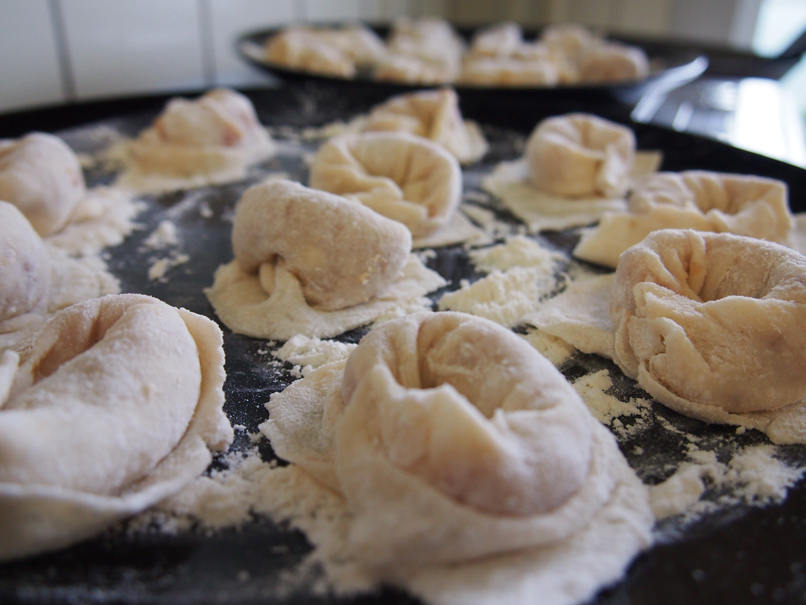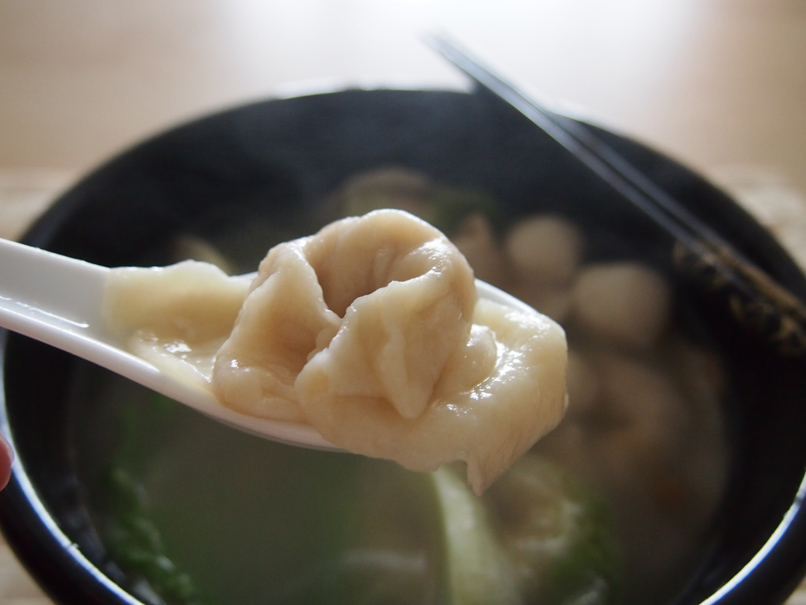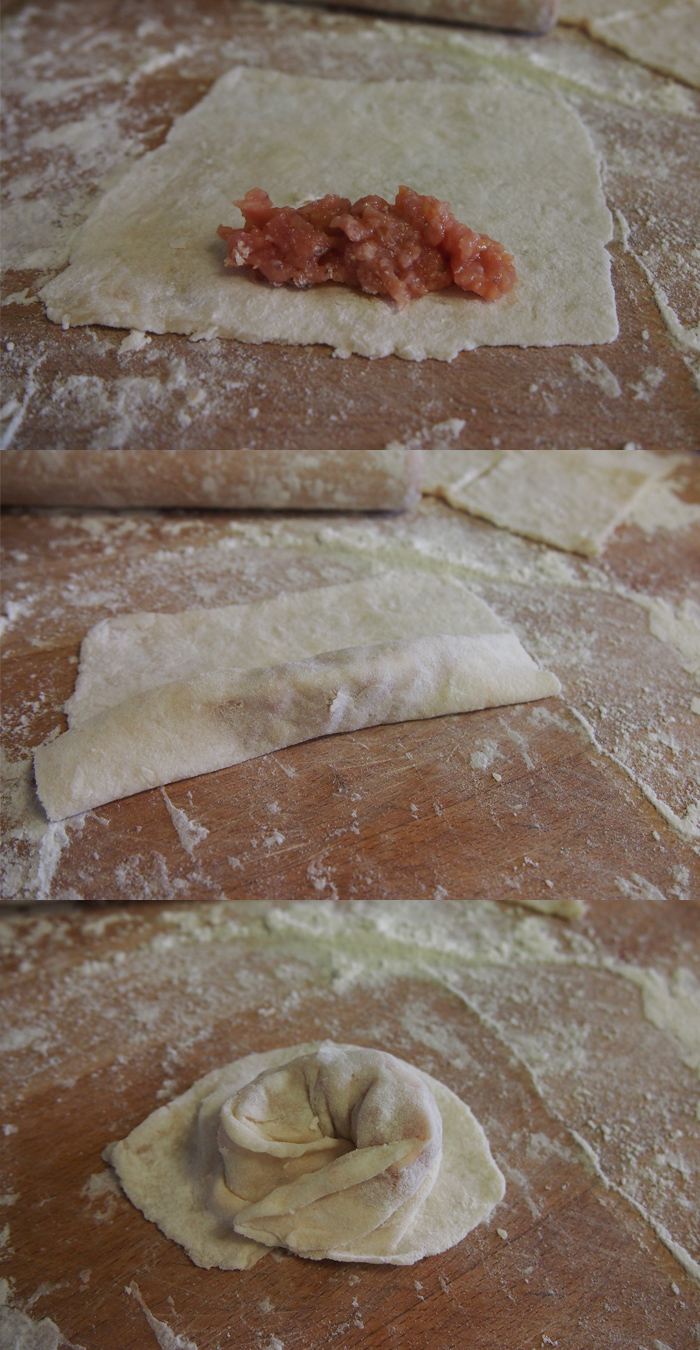I think I must be the first person to write down this recipe in a western language.
Originally from Chaozhou (Teochew) region of the Guangdong (Canton) province, Teochew fish dumplings are not well-known in the rest of China but are extremely popular in Singapore. Never featured exclusively on its own, you will always find one or two fish dumplings in your fishball noodles. In its homeland, the fish dumplings are a meal on its own, served in a soup.
I must first proclaim that this is my first time making these fish dumplings, and the recipe comes from Teochew websites written in Chinese. As far as I can tell, it takes many years of experience to make these dumplings and an experienced master will make these as small as possible and use as little flour as possible to make the dumpling skin malleable and not break. If you are a novice like me, the best thing to do is to first make them big enough to learn how to fold them correctly and to use enough flour to prevent the skin from sticking. Thus, I will not indicate the amount of flour to use, you should just keep it to a minimum.

In recent decades, chefs in Singapore began adding gelatine to the filling to create a lovely thick juice that oozes out when you bite it. I must admit that I am not familiar with that method and would love to receive feedback from you if you know how it is done.
The initial process of making the dumpling skin is the same as for fishballs. I cannot find the fish used in Singapore and am using tilapia which I consider to be the closest albeit not ideal alternative.
Ingredients:
Dumpling skin:
- 350g tilapia filet, skinless and boneless
- 3 tsp salt
- Plain flour
- Egg white of 2 eggs
Filling:
- Egg yolk of 2 eggs
- 100g fatty pork
- 100g raw prawn meat
- 2cm salted fish
- 2 tbs oil
- Salt and pepper
Steps:
- First we have to make the filling. Crush your salted fish into tiny bits. Heat up your wok with some oil and fry the salted fish. Do not let it char. Remove from wok. Place your fatty pork, prawn and salted fish into a food processor and grind it to a smooth mixture. Take it out into a bowl, add in your egg yolk and some salt and pepper. Mix well and place it in the fridge to marinate.
- Cut your fish into shorter pieces and place them in your food processor with your salt. It is important to make sure there are absolutely no bones in your fish. Once you get a very finely ground fish paste, add in your egg white and continue grinding it until everything is well mixed.
- Take your fish paste out of the food processor into a plastic basin. Now, use one hand to hold the basin tight and the other to grab the whole of the fish paste and throw it hard against the side of the basin. Repeat this process for about 20 minutes. This will cause the fish paste to turn into a bouncy hard dough, due to the breakdown of the protein structure. The liberal amount of salt added just now also dries up the fish paste, helping to strengthen the texture into a fish dough.
- Take your filling out of the fridge.
- On a large workspace, sprinkle some plain flour to the surface and onto your rolling pin. Take your fish dough and flatten it across the surface, first with your hands then with the rolling pin. You should aim to have your fish dough flattened to at most 3mm thick.
- Cut your flattened fish dough into squares of about 8x8cm. If it sticks to the surface lift each skin up with a knife. Imagine there are three sections to your square. On the lower section, use a pair of chopsticks or teaspoon to lay it with about 2cm2 volume of filling. Lay your filling long and thin but without fully reaching either ends. Roll the skin upwards onto the middle section, until it reaches the upper section. While thrusting the filled section slightly upwards, clip both ends of that section and bring them together. You should have a filled ball in the centre with a flap of skin around it.
- Do the same until you have exhausted your filling or skin. You can place your completed dumplings on wax paper.
- You’re done! You can either cook them immediately or freeze them for later use.
How to eat it: I boil my dumplings in boiling water to get rid of the flour before adding them to a soup. Otherwise, they also taste great when deep-fried. If you cannot finish eating them, try freezing them for later use.




Hi, thanks for your recipe. I realised that the recipe Only mentioned to put some flour on the rolling pin. Do we have to add flour into the fish dough also?
Hi there, it’s been some time since I’ve made this. I don’t recall adding flour in the fish paste because the flour on the rolling pin is enough to dilute the taste and is meant only to prevent it from sticking to the rolling pin. As mentioned, keep the flour to a minimum or the wrap will lose too much of its taste to the flour. It’s a difficult thing to make, to be honest. But good luck! 😉
Thanks so much. Waiting forever for fish dumpling without laden flour until gave up. Thanks for recipe.
Don’t give up! It’s a fine balance between the flour and the fish paste. Too much flour will make it easy to mould but will lose the taste of the fish. It’s a fine balance indeed…
I’m so glad that I found your recipe. This is not a common dish found among the Asian food bloggers writing in English, thank you so much.
hi there
when u start throwing the fish paste.do you wet your nads before grabbing it. As it get messy with dry hands.
Tks for your input
Hi,
It is quite messy but I didn’t wet my hands. Once the paste gets sticky and you add more flour it will become better.